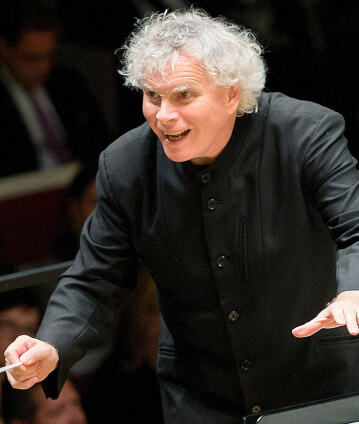Simon Rattle conducts Brahms, Lutosławski and Widmann

This concert is almost a condensed retrospective of the Rattle era. For example, Sir Simon’s enthusiasm for contemporary music is revealed in the premiere of a short work by Jörg Widmann; in Lutosławski’s Third Symphony, on the other hand, he once again shows what imaginative music the 20th century has left behind, and finally, Rattle’s continuous work on the great classics of the repertoire is represented by Brahms’s First Symphony.
Sir Simon Rattle remembers well as a young man hearing the first broadcast of Witold Lutosławski’s Third Symphony. “I felt immediately: we have a great masterpiece here, which is in it’s way also a concerto, a concerto for orchestra, a concerto which makes use of the freeness of time, how chance can make music collide and work again at a different level.” The symphony, composed over a ten year period, was commissioned by the Chicago Symphony Orchestra. It was given its premiere in 1983 under the baton of Sir Georg Solti, and was a great success for its composer from the start. Lutosławski’s compositional style was decisively influenced by the ideas of the musical avant-garde which established itself after World War II, and whose music he discovered at the “Warsaw Autumn” festival which he founded. Under the influence of serial composition techniques, he developed the principle of “controlled aleatorism” which also characterises his Third Symphony: phrases in which the musician play in their own time alternate with strictly composed parts. The Berliner Philharmoniker performed the symphony for the first time in 1985 under the direction of Lutosławski, who between 1978 and 1985 often conducted his own works with the orchestra.
Johannes Brahms is also among the composers who have conducted the Philharmoniker. In January 1884, barely two years after the orchestra was founded, he made his debut as the soloist in his First Piano Concerto and as the conductor of his Third Symphony. As such, the works of Brahms are very much part of the orchestra’s musical DNA. When Brahms presented his Symphony No. 1 to the public, he had long since made a name for himself in the field of choral, chamber and piano music. But he struggled with the form of his First Symphony for 15 years, the legacy of Beethoven weighed so heavily on him. Although the model of the First Viennese School is unmistakable, manifesting itself especially in the heroic, monumental spirit of the work, Brahms still reveals his unique compositional style: to develop, vary and transform the work’s themes and motifs from one primary motivic cell.
Another work from the “Tapas” series initiated by Sir Simon opens the concert, on this occasion a work by Jörg Widmann. The Philharmoniker have performed a number of works by the Munich-born composer and clarinettist, most recently his symphonic hymnos Teufel Amor.
© 2018 Berlin Phil Media GmbH
Related interviews
Artists
Our recommendations
- Conclusion of the Sibelius cycle with Simon Rattle
- “Carmen” with Simon Rattle, Magdalena Kožená and Jonas Kaufmann
- Simon Rattle conducts Bruckner and Widmann
- Mozart’s “Magic Flute” from Baden-Baden
- Krystian Zimerman and Simon Rattle perform Bernstein’s “The Age of Anxiety”
- Simon Rattle conducts “Russian rhythms” at the Waldbühne